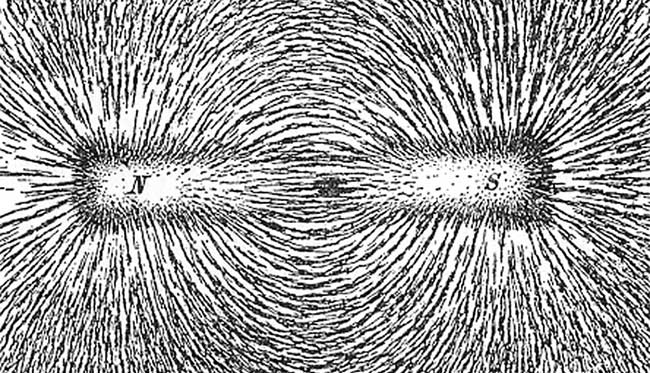The mystery of the origin of magnetic fields in the universe
Magnetic fields are everywhere in the universe, but where do these magnetic fields come from?
How the universe came to have such vast magnetic fields is one of the most pressing problems in astrophysics.
Recently, researchers have come up with a completely new explanation. They believe that the magnetic field in the universe is born from a giant "dust battery" that was active when the first stars appeared.

Diagram of the magnetic field of a muon (Photo: Newton Henry Black/ Wikimedia commons).
Magnetic fields are everywhere in the vastness of space. Earth's magnetic field deflects dangerous cosmic radiation, vibrates compass needles, and guides migrating birds.
Other planets and stars also have magnetic fields. The magnetic fields of Jupiter and the Sun are stronger than Earth's. The entire Milky Way galaxy also has a magnetic field, but it is about a million times weaker than Earth's. However, it extends for tens of thousands of light years, through the entire galaxy.
Astronomers know of even larger magnetic fields, some so large that they encompass entire galaxy clusters several million light-years across.
So where do these giant magnetic fields come from? Although they are weak, they are extremely large. So whatever is creating them must come from a very powerful source.
For decades, astronomers have suggested that there are a number of mechanisms, most of which rely on a dynamical process that takes weak "seed" fields and amplifies them to their present values.
However, that raises the question of where do those weak seed schools come from?
Recently, astronomers have come up with a completely new explanation.
In this scenario, the scene is the dawn of the universe, when the universe was only a few hundred million years old, the first stars and galaxies began to shine. After the first stars died, they left behind bits of heavier elements. These elements found each other in interstellar space and became the first dust grains.
These dust grains often carry electrical charges due to bombardment by radiation and friction with each other. When the second generation of stars shines, their intense light shines through all the surrounding gas and dust.
If these stars are powerful enough, their radiation can push dust grains through the rest of the gas. These moving charged dust grains will generate a weak but large-scale electric current, like a copper wire 1,000 light years long.
Because the filtering of radiation through interstellar gas is not uniform, moving dust particles tend to clump together in some places and spread out more widely in others. This creates differences in electric currents from place to place, which, through the laws of electromagnetism, naturally generates magnetic fields.
In this new study, the scientists found that this magnetic field was very weak, only about 1 billionth the strength of Earth's magnetic field, but still large enough that other astrophysical processes could latch onto that seed field and create the magnetic field we see today.
Still, this is just a hypothesis. The result is a formula that simulates the evolution of galaxies and their magnetic fields. This is an important step in comparing the entire field theory with the magnetic fields we see in the universe.
Going back in time to see where the magnetic field in the universe came from is impossible, but we can use ideas and hypotheses like these to gradually reconstruct a picture of the past, in the whole ambition of understanding the vast universe of which our home, Earth, is a part.
- Young galaxies have surprisingly strong magnetic fields
- The neural neuron of the worm senses magnetic fields
- The black spot The sun is about to disappear?
- Marvel at the magnitude of the central Milky Way
- New discoveries about geomagnetic fields of polar islands
- New materials help solve the mystery of the Earth's magnetic field
- The mystery of the origin of the universe: Can each black hole give birth to a baby universe and do we live in a black hole?
- Without magnetic fields, Venus still has an aurora
- NASA simulates invisible magnetic fields on the Sun.
- First discovered magnetic field at distant galaxy
- Admire the galaxy's magnetic field with high resolution
- Application of magnetic fields to make refrigerators in the future
 'Fine laughs' - Scary and painful torture in ancient times
'Fine laughs' - Scary and painful torture in ancient times The sequence of numbers 142857 of the Egyptian pyramids is known as the strangest number in the world - Why?
The sequence of numbers 142857 of the Egyptian pyramids is known as the strangest number in the world - Why? History of the iron
History of the iron What is alum?
What is alum?